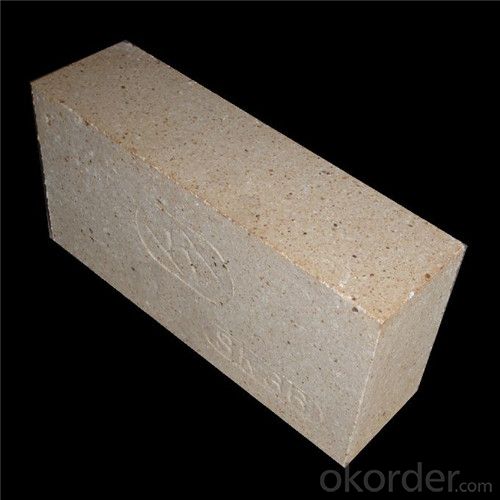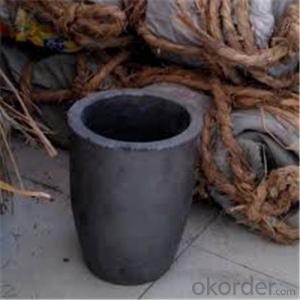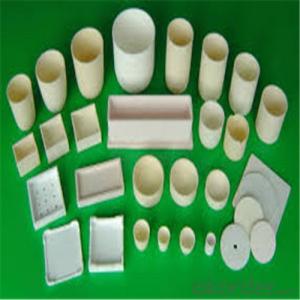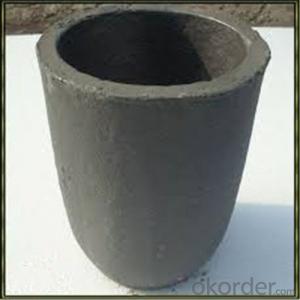High Temperature Melting Graphite Crucibles - SIC Grade
- Loading Port:
- Shanghai
- Payment Terms:
- TT OR LC
- Min Order Qty:
- 1 pc
- Supply Capability:
- 1000 pc/month
OKorder Service Pledge
OKorder Financial Service
You Might Also Like
Quick Details
| Application: | melting metals | Height: | depends on your requirement | Top Diameter: | 10-1200mm |
| Bottom Diameter: | 10-1200mm | Place of Origin: | China (Mainland) | Brand Name: | |
| product name: | SiC graphite crucible china graphite crucible | top diameter: | 10-1200mm | bottom diameter: | 10-1200mm |
| height: | depends on your requirement | application: | melting gold,silver and other metals | Specific resistance: | ≤14μΩ.m |
| Bending strength: | ≥25MPa | Compressive strength: | ≥50MPa | Bulk densit: | ≥1.68g/cm3 |
| Ash content: | ≤0.15% |
Packaging & Delivery
| Packaging Details: | woden case for SiC graphite crucible china graphite crucible |
| Delivery Detail: | within 20 days |
Introduction
1. Graphite crucible can be used for non-ferrous metal smelting and casting, dissolving gold
or silver ornaments, analysis of special type steel, sintering hard metal.
2. graphite crucible for smelting gold is specialized in melting gold in headgear and jewelryindustry. That requests graphite material has high density and purity, ablation-resistance, and it can be used many times. We can machine various crucibles accordingto customer's requirement.
3. Machined from high pure graphite and widely used in the gold,silver,platinum and other noble metal's melting.If it's used in oxygen atmosphere,it wil start to be oxygenized when the temperature is higher than 700-800°c. If it's used in the protective atmosphere, it can stand more than 2000°c.
4. widely used in such fields as industrial furnaces, mono-crystalline silicon machinery, mono-crystalline silicon machinery, electron, semi-conductor, metallurgy, oil, chemistry, textile, electrical machinery, electrical equipment, electrical furnace, traffic, communication industry, medicine, etc.
Advantages
1.good thermal conductivity
2.High-temperature resistance
3. Small thermal expansion coefficient.
4.Strong corrosion resistance to acid and alkali liquid
5.Good chemical stability
Technology parameter
Item | Unit | High pure graphite | ||
baked twice | baked three time | baked four times | ||
impregnated once | impregnated twice | impregnated three times | ||
Grain size | mm | ≤325mesh | ≤325mesh | ≤325mesh |
Bulk density | g/cm3 | ≥1.68 | ≥1.78 | ≥1.85 |
Specific resistance | μΩ.m | ≤14 | ≤14 | ≤13 |
Bending strength | MPa | ≥25 | ≥40 | ≥45 |
Compressive strength | MPa | ≥50 | ≥60 | ≥65 |
Ash content | % | ≤0.15 | ≤0.1 | ≤0.05 |
We accept small orders,please inquiry us freely. | ||||
Item | Unit | Fine-grain Specialty Graphite model 1 | Fine-grain Specialty Graphite model model2 | ||
Guarantee value | Typical value | Guarantee value | Typical value | ||
Max grain size | mm | 0.8 | 0.8 | 0.8 | 0.8 |
Bulk density | g/cm3 | ≥1.70 | 1.73 | ≥1.73 | 1.76 |
Specific resistance | μΩ.m | ≤8.5 | 7.5 | ≤8.0 | 7 |
Bending strength | MPa | ≥10.0 | 11 | ≥12.0 | 12.5 |
Compressive strength | MPa | ≥24.0 | 27 | ≥31.0 | 34 |
Thermal Condcutivity | W/(m.k) | ≥120 | 150 | ≥130 | 160 |
C.T.E.(100-600) °C | 10-6/°C | ≤2.5 | 2.2 | ≤2.5 | 2.1 |
Ash content | % | ≤0.3 | 0.09 | ≤0.3 | 0.09 |
We are always avliable to service you! | |||||
Parts sizes of graphite crucible table
Product name | Dimensions(mm) | Weight(g) | |||
Φ1 | Φ2 | Φ3 | H | ||
1 kg graphite crucible | 58 | 47 | 35 | 88 | 160 |
2kg graphite crucible
| 65 | 58 | 44 | 110 | 240 |
2.5kg graphite crucible
| 65 | 58 | 44 | 126 | 300 |
3kg graphite crucible
| 85 | 75 | 60 | 105 | 390 |
4kg graphite crucible
| 85 | 75 | 60 | 130 | 500 |
4kg graphite crucible
| 85 | 75 | 60 | 136 | 500 |
5kg graphite crucible
| 100 | 89 | 69 | 130 | 700 |
5.5kg graphite crucible
| 105 | 90 | 70 | 156 | 800 |
6kg graphite crucible
| 110 | 97 | 79 | 174 | 970 |
We have all kinds of sizes graphite crucibles in stock,please feel free to contact us. | |||||
packaging & shipping
Packaging
1. For each type, we can send you the detailed high-resolution pictures since we have the sample in our hand.
2. For packaging, we have the professional packaging starff, pls. don't worry about the shipping.
Our service
1.Delivery time is 5~7 days for sample and 15 working days for bulk order;
2. Strong production capacity and strict quality control system;
3. Your inquiry and problems related to our products or prices will be replied in 24 hours;
4. Well-trained and experienced staffs to answer all your inquires;
5. After-sale tracking service for all of our clients;
6. OEM is available; small quantities, mixed bulk orders are also welcome;
7. Payment: L/C, D/A, D/P, T/T, Paypal , Western Union, MoneyGram;
8. Delivery way: UPS, DHL, TNT, FEDEX, EMS, CHINA POST.
After-Sales Service
1.1year warranty for most of our products;
2.We will arrange delivery of the goods on time:
3.Within the warranty period, we will bear all the qulity problem of our produts;
4.Beyond the warranty period, we will despatch the replacement parts to help fix the products;
5.Without any problem, we will gain the feedbacks of our products to help improve better products.
FAQ
Q:How to get in touch with us?
A:You can clik "Contact Supplier" above, or click "Chat Now!". We provide 24-hour service!
Q: How can I get free samples?
A: Only carbon brush for power tools/automobiles/motorcycle----no more than 4 sets for each model is free of charge.
Q:How to order?
A:Quotation→Price comfirming→Sign a contract→Mass production→Delivery
Q:How to pay?
A:30% T/T deposit.→70% balance by T/T against B/L copy.
Q:How to get after-sales service?
A:You can contact with your appointed sales.
You can also get in touch with our Quality Assurance Department: zdatzddt.com
Company Information


Other refractory materials for High temperature industry


- Q: What are the main changes in graphene supercapacitors?
- The advent of graphene supercapacitors, the first change is electronic products and digital products, why do you say so? Because the ultracapacitor is obviously charging and discharging faster. So, for example, mobile phone charging, electric cars, electric cars, computers and other products will decline in price. The birth of super capacitors indicates that mobile phones can become thinner and smaller, because the space that the battery takes can be smaller.
- Q: How is graphite formed?
- The company has advanced production and processing equipment, modern production management, perfect product testing means, a good service network and strong development capabilities. For customers to produce all kinds of special-shaped, high-precision graphite products! Such as: graphite plate, graphite rod, graphite block, graphite crucible, graphite anode plate, graphite mold, graphite lining, graphite bearing, Shi Mohuan, graphite tube, graphite pad, graphite electrode and so on.
- Q: What is the use of graphite for corrosion resistance?
- It is widely used in petroleum, chemical, hydrometallurgy, acid and alkali production, synthetic fiber, paper making and other industrial sectors. It can save a great deal of metal materials.
- Q: Can graphite crucibles be used for diamond synthesis?
- Diamond synthesis cannot be achieved using graphite crucibles. Despite both graphite and diamond being forms of carbon, they possess distinct structures and properties. Graphite exhibits a layered structure with weak bonding between layers, enabling it to conduct electricity and heat proficiently. Conversely, diamond features a three-dimensional structure with robust covalent bonds between carbon atoms, rendering it the hardest substance and a poor conductor of electricity. During the diamond synthesis process, carbon is converted into diamond utilizing elevated temperatures and pressures. Unfortunately, graphite crucibles lack the capability to endure such extreme conditions and would react with the carbon. Consequently, this reaction would yield more graphite instead of diamond. To synthesize diamonds successfully, specialized equipment such as high-pressure, high-temperature (HPHT) or chemical vapor deposition (CVD) techniques are utilized, necessitating different materials capable of withstanding the required conditions.
- Q: Are there different sizes available for graphite crucibles?
- Yes, there are different sizes available for graphite crucibles.
- Q: The difference between single graphite furnace graphite furnace atomic absorption spectrophotometer and double graphite furnace
- The graphite furnace atomic absorption spectrometer and the flame atomic absorption spectrophotometer belong to the atomic absorption spectrometer. They are composed of light source, atomization system, spectroscopic system and detection system.
- Q: Can graphite crucibles be used for plasma arc melting?
- Yes, graphite crucibles can be used for plasma arc melting. Graphite has excellent heat resistance and electrical conductivity properties, making it suitable for containing and melting materials under high temperatures generated by plasma arcs.
- Q: Can graphite crucibles be used with induction melting furnaces?
- Induction melting furnaces can indeed utilize graphite crucibles. The thermal conductivity and elevated melting points of graphite crucibles render them highly suitable for induction melting furnaces. The remarkable conductivity facilitates efficient heat transfer, guaranteeing even heating of the molten metal. Furthermore, graphite crucibles exhibit commendable resilience against thermal shock, a critical attribute in the intense heat atmosphere of induction melting furnaces. Nevertheless, it is imperative to ascertain that the graphite crucible is compatible with the precise metal being melted to prevent any chemical reactions or contamination.
- Q: What are the different methods of preventing contamination from graphite dust?
- To prevent contamination from graphite dust, there are several approaches that can be utilized. 1. Ventilation Systems: It is crucial to install appropriate ventilation systems in areas where graphite dust is produced. These systems play a vital role in capturing and eliminating dust particles from the air, thereby reducing the risk of inhalation or settling on surfaces. 2. Enclosures and Barriers: Creating physical barriers and enclosures around areas where graphite dust is generated can effectively contain the particles within a controlled space. This containment prevents the dust from spreading to other parts of the facility or affecting nearby equipment. 3. Personal Protective Equipment (PPE): Workers who are exposed to graphite dust should wear suitable PPE to minimize contamination. This may include respiratory masks or respirators, goggles, gloves, and protective clothing to prevent direct contact with the dust. 4. Regular Cleaning and Maintenance: Strict adherence to a cleaning and maintenance schedule is essential in preventing the accumulation and spread of graphite dust. Surfaces, equipment, and machinery should be regularly cleaned using methods that minimize dust dispersion, such as wet cleaning or vacuuming with HEPA filters. 5. Process Modification: Altering the production process can also be effective in preventing graphite dust contamination. Implementing measures like wet cutting or machining instead of dry processes significantly reduces the generation and spread of dust particles. 6. Training and Awareness: Educating workers about the hazards of graphite dust and providing training on proper handling, cleaning, and maintenance procedures are crucial in preventing contamination. Workers should be informed about the risks associated with graphite dust exposure and equipped with the knowledge to take necessary precautions. By employing a combination of these methods, facilities can successfully prevent contamination from graphite dust and ensure a safe and healthy working environment.
- Q: Can a graphite crucible be used for ceramic glazing?
- Using a graphite crucible for ceramic glazing is not possible. Graphite, a form of carbon with a high melting point, is commonly used for melting metals. However, ceramic glazing requires a crucible that can resist high temperatures and provide a non-reactive environment for the glaze to adhere properly to the ceramic. To meet these requirements, porcelain or stoneware crucibles are needed. These materials are capable of withstanding the high firing temperatures and do not react with the glaze. If a graphite crucible is used, it may react with the glaze and contaminate it, resulting in poor quality or unsuccessful glazing. Thus, it is crucial to use crucible materials specifically designed for ceramic glazing processes.
Send your message to us
High Temperature Melting Graphite Crucibles - SIC Grade
- Loading Port:
- Shanghai
- Payment Terms:
- TT OR LC
- Min Order Qty:
- 1 pc
- Supply Capability:
- 1000 pc/month
OKorder Service Pledge
OKorder Financial Service
Similar products
Hot products
Hot Searches
Related keywords




























